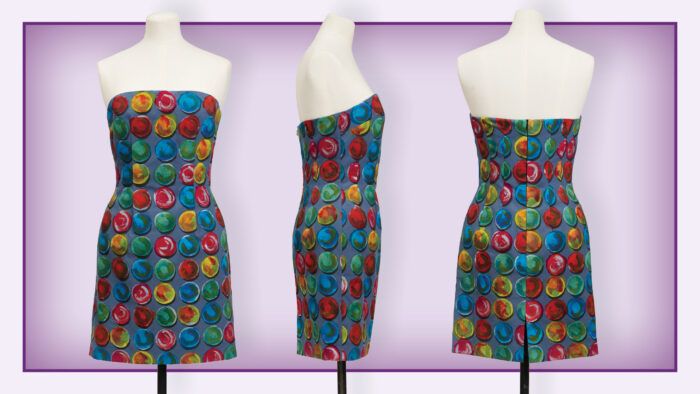Runway Sewn Your Way: Gilbert Muniz’s Dress Made With Hand-Printed Fabric
A simple strapless design draws the eye to the painted floating circles motif
When choosing the cut for my Runway Sewn Your Way Challenge garment, I wanted to capture the essence of the Versace Pre-Fall 2019 Collection and keep the design firmly within my style wheelhouse. I am fascinated with clean, strict cuts in clothing. My own work tends to be more classic tailoring than anything else, especially since I work with such diverse fabric prints and embellishments.
Simple dress for a bold, hand-printed fabric
As stated in my first Runway Sewn Your Way Challenge post, I tend to keep the cuts clean if the fabric is bold. Hand-painted floating circles in linear unison leans decidedly into bold territory, so the cut would need to stem from the less exaggerated pieces of the season’s line.
Learn how I hand-printed the fabric for the floating circles dress here.
The original look that caught my eye was the strapless, heart print satin dress toward the end of Versace’s Pre-Fall 2019 Collection runway show. That piece is essentially a tube dress with boning and a stretched overlayer. The repeating, bold print is the standout on this look, and the cut reflects its splendor perfectly. Hopefully, my design below captures that essence.
There were other cuts in this collection I wanted to explore that had exaggerated tucks and cutouts that work well for solid fabrics. When paired with a conversational print, however, they end up looking confusing and jarring.
Though my design wasn’t printed on stretch satin, I eliminated as many seams as possible and focused on darts for shaping.
Built with a foundation
I built the outer layer on a strapless bra cup bustier. This allowed me to use minimal construction on the outer layer and focus all of the heavy construction on the foundation. The two would be connected at the neckline. The bustier closes with hooks and eyes, and the dress with an invisible zipper.

I prefer working with a foundation for strapless pieces like this dress because it gives me more options with seams and details. The cut of the outer dress only has to match at the neckline. The shape and seaming can be mutually exclusive from that point on. The seams on the bustier were felled, which creates a channel that the boning can slip into. I prefer this technique on undergarments because it cuts down on having to make boning casings. This bustier foundation is made of black silk shantung and the cups are lined in silk charmeuse.


Support added
Because the fabric I printed was lightweight, I underlined the entire dress in silk organza. This gives it more body and absorbs wrinkles.

Print-matching issues
One of the main challenges I had with this dress was matching the circle motifs on the hand-printed fabric. As much as I wanted to get them perfect, I settled for in line across the body. Since all the circles were hand-printed and not digitally lined up prior to burning a silk screen, some of the motifs weren’t in perfect horizontal alignment. Another limitation was how much fabric I printed and how wide the pattern pieces were.
I lined the dress in a hand-dyed habutai. It needed to be lined because most of the dress’s skirt would be against the body.

Normally, for garment construction like this, I would sew the bustier to the outer garment. Because the dress was so light and close to the body, I didn’t need it. There’s no harm in creating thread chains to connect the two, but this piece is fine without them.
Challenge yourself
Doing this challenge was a blast. I always look to the runways for designer inspiration but rarely get to dive deep into specifics about how I interpret the work. Fashion shows offer a vast array of details and ideas that can easily translate into any custom-made garment. And it’s never about directly copying the design; it’s always up to the maker to put their spin on what they see. I hope I’ve inspired you to challenge yourself to rethink the way a print or detail can be made your way.
Photos: Mike Yamin, except where noted.




































Log in or create an account to post a comment.
Sign up Log in